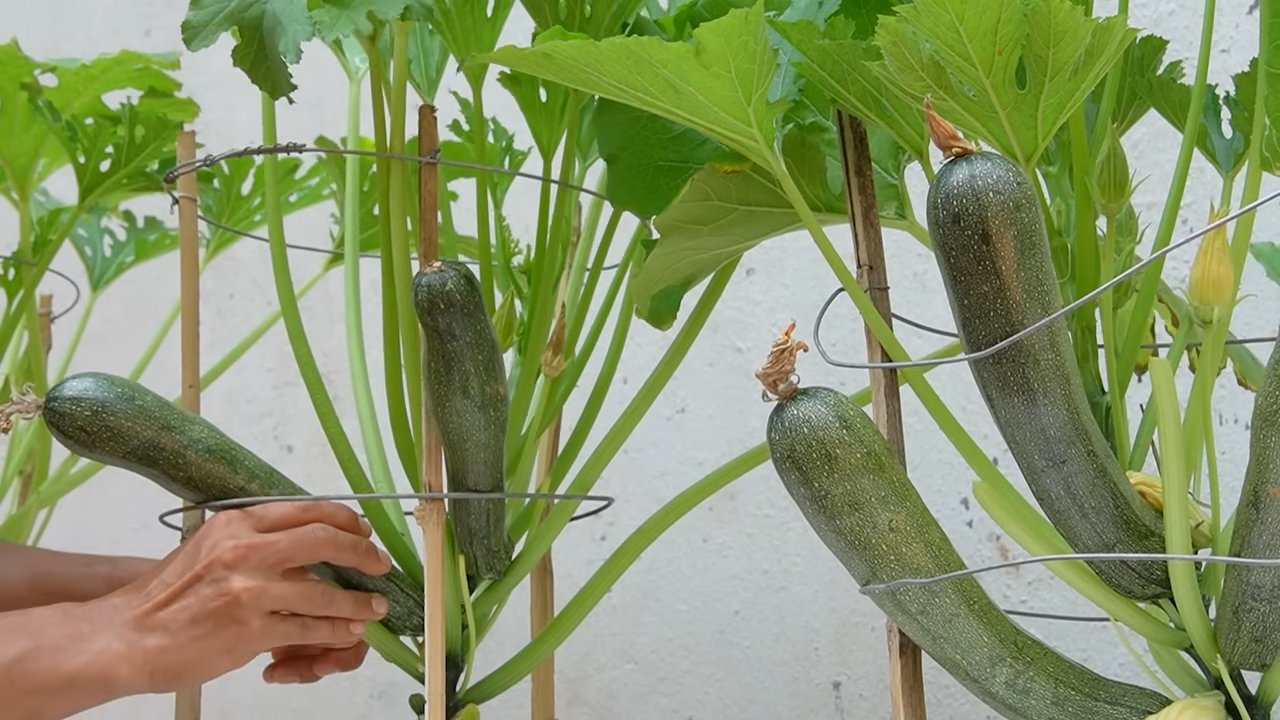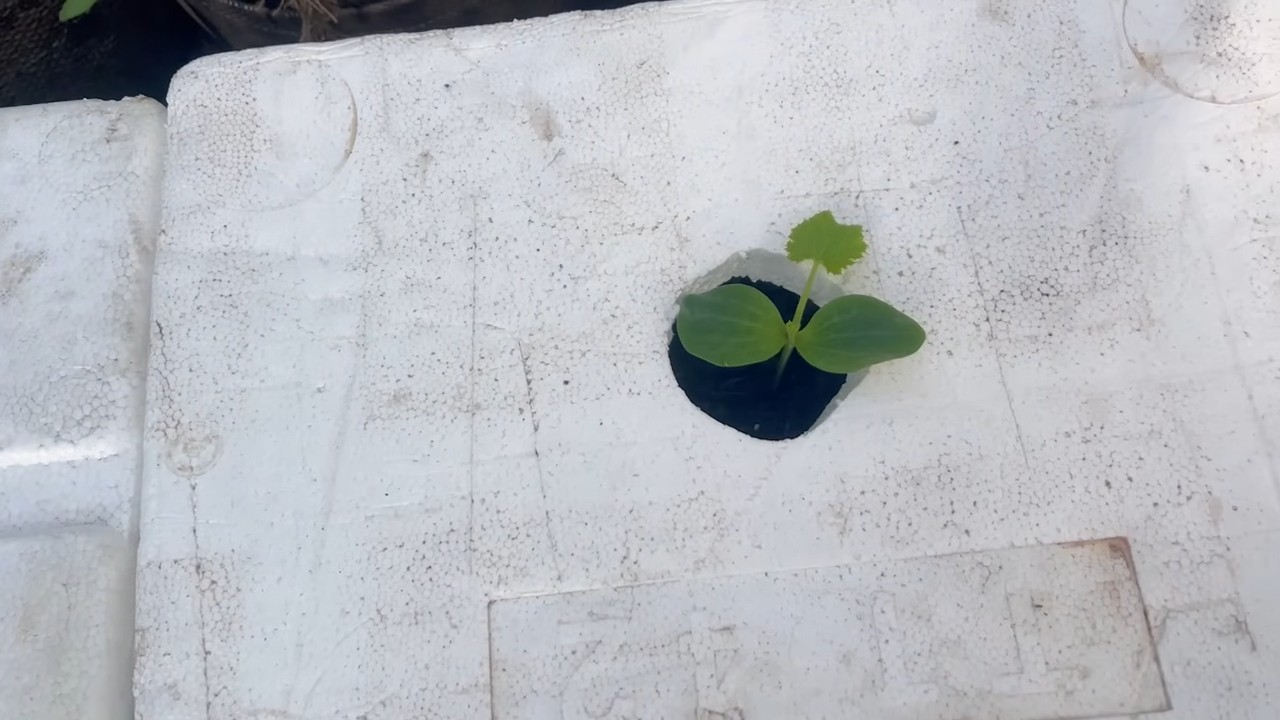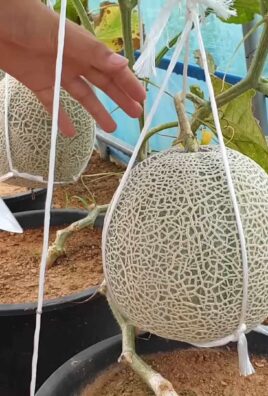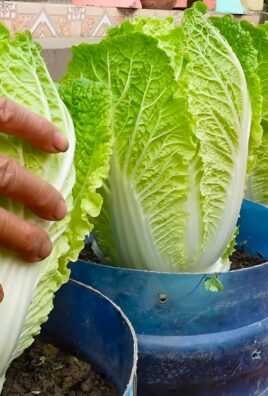Easy Zucchini Growing Method: Unlock the secrets to a bountiful harvest right in your backyard! Have you ever dreamed of stepping outside and picking fresh, vibrant zucchini whenever you need it? I know I have! But sometimes, growing these seemingly simple vegetables can feel like a frustrating battle against pests, diseases, and unpredictable weather.
Zucchini, a member of the squash family, has a rich history, tracing back to Central and South America thousands of years ago. While its exact origins are debated, its cultivation has spread globally, becoming a staple in cuisines worldwide. From savory dishes to sweet treats, zucchini’s versatility is undeniable.
That’s why I’m so excited to share this easy zucchini growing method with you. Forget complicated techniques and endless gardening woes! This DIY guide is packed with practical tips and tricks that will help you cultivate healthy, productive zucchini plants, even if you’re a complete beginner. Imagine the satisfaction of harvesting your own homegrown zucchini, knowing exactly where it came from and how it was grown. Plus, you’ll save money at the grocery store and enjoy the freshest, most flavorful zucchini imaginable. Let’s get started and transform your garden into a zucchini paradise!

Unlock the Secret to Bountiful Zucchini: My Foolproof Growing Method!
Hey there, fellow gardening enthusiasts! Are you dreaming of mountains of zucchini this summer? I’m here to tell you that it’s totally achievable, even if you think you have a “brown thumb.” I’ve perfected a super easy zucchini growing method over the years, and I’m excited to share it with you. Forget complicated techniques and fussy routines 鈥?this is all about simplicity and maximizing your harvest. Let’s get started!
Choosing the Right Zucchini Variety
Before we even think about planting, let’s talk zucchini varieties. This is important because different types have different growth habits and disease resistance. Here are a few of my favorites:
* Black Beauty: A classic, reliable variety with dark green, almost black skin. It’s a prolific producer and relatively disease-resistant.
* Costata Romanesco: This Italian heirloom has beautiful ridged fruit with a nutty flavor. It’s a bit more compact than some other varieties.
* Golden Zucchini: Adds a pop of color to your garden and your plate! The flavor is similar to green zucchini.
* Round Zucchini (Eight Ball, One Ball): These are perfect for stuffing! They’re also great for smaller gardens.
Consider your space and your taste preferences when choosing your zucchini variety. Read the seed packet descriptions carefully to understand the plant’s mature size and any specific growing requirements.
Preparing Your Zucchini Planting Site
Zucchini plants are hungry, hungry hippos! They need rich, well-drained soil to thrive. Here’s how I prepare my planting site:
* Sunlight: Zucchini needs at least 6-8 hours of direct sunlight per day. Choose a spot in your garden that gets plenty of sunshine.
* Soil: Zucchini prefers well-drained soil that is rich in organic matter. If your soil is heavy clay or sandy, amend it with compost or well-rotted manure.
* Soil pH: Zucchini grows best in soil with a pH between 6.0 and 7.5. You can test your soil pH with a soil testing kit.
* Spacing: Zucchini plants can get quite large, so give them plenty of space. I recommend spacing plants 2-3 feet apart.
Step-by-Step Planting Guide
Now for the fun part 鈥?planting! I usually start my zucchini seeds indoors a few weeks before the last expected frost, but you can also direct sow them in the garden once the soil has warmed up.
1. Starting Seeds Indoors (Optional):
* Fill seed trays or small pots with seed-starting mix.
* Plant 2-3 seeds per cell, about 1 inch deep.
* Water gently and keep the soil moist but not soggy.
* Place the seed trays in a warm, sunny location or under grow lights.
* Once the seedlings have developed a few true leaves, thin them to one plant per cell.
* Harden off the seedlings by gradually exposing them to outdoor conditions for a week before transplanting.
2. Direct Sowing Seeds:
* Wait until the soil temperature is consistently above 60掳F (15掳C).
* Prepare the planting site as described above.
* Sow seeds 1 inch deep and 2-3 feet apart.
* Water gently and keep the soil moist.
* Once the seedlings emerge, thin them to one plant per spot.
3. Transplanting Seedlings:
* Dig a hole that is slightly larger than the root ball of the seedling.
* Gently remove the seedling from its container and loosen the roots.
* Place the seedling in the hole and backfill with soil.
* Water thoroughly.
* Add a layer of mulch around the plant to help retain moisture and suppress weeds.
Watering and Feeding Your Zucchini Plants
Zucchini plants need consistent watering, especially during hot, dry weather. I like to water deeply and infrequently, rather than shallowly and often.
1. Watering:
* Water deeply at the base of the plant, avoiding wetting the leaves. This helps prevent fungal diseases.
* Water early in the morning so the leaves have time to dry before nightfall.
* Check the soil moisture regularly and water when the top inch of soil feels dry.
* During hot weather, you may need to water daily.
2. Fertilizing:
* Zucchini plants are heavy feeders, so they need regular fertilization.
* I like to use a balanced fertilizer (e.g., 10-10-10) at planting time.
* Side-dress the plants with compost or well-rotted manure every few weeks.
* You can also use a liquid fertilizer, such as fish emulsion or seaweed extract, every 2-3 weeks.
Dealing with Pests and Diseases
Zucchini plants are generally easy to grow, but they can be susceptible to certain pests and diseases. Here are a few common problems and how to deal with them:
* Squash Vine Borers: These pests can tunnel into the stems of zucchini plants and kill them. Look for small holes in the stems and sawdust-like frass. To prevent squash vine borers, you can wrap the base of the stems with aluminum foil or netting. If you find borers, you can try to remove them by slitting the stem and extracting them.
* Squash Bugs: These pests suck the sap from zucchini leaves, causing them to wilt and die. Handpick squash bugs and their eggs (which are usually found on the undersides of leaves) regularly. You can also use insecticidal soap to control them.
* Powdery Mildew: This fungal disease causes a white, powdery coating on the leaves. To prevent powdery mildew, water at the base of the plant, provide good air circulation, and avoid overcrowding. If you see powdery mildew, you can treat it with a fungicide.
* Blossom End Rot: This condition causes the ends of the zucchini fruit to rot. It’s usually caused by calcium deficiency or inconsistent watering. To prevent blossom end rot, make sure your soil is rich in calcium and water consistently.
Harvesting Your Zucchini
The best part of growing zucchini is, of course, harvesting it! Zucchini grows quickly, so you’ll need to check your plants regularly.
1. When to Harvest:
* Harvest zucchini when it is young and tender, usually when it is 6-8 inches long.
* Larger zucchini can be tough and seedy.
* Harvest regularly to encourage the plant to produce more fruit.
2. How to Harvest:
* Use a sharp knife or pruning shears to cut the zucchini from the plant.
* Cut the stem close to the fruit.
* Handle the zucchini carefully to avoid bruising it.
My Top Tips for Zucchini Success
Over the years, I’ve learned a few tricks that have helped me grow even more zucchini. Here are my top tips:
* Companion Planting: Plant zucchini with companion plants like marigolds, nasturtiums, and basil to deter pests.
* Mulching: Mulch around your zucchini plants to help retain moisture, suppress weeds, and regulate soil temperature.
* Hand Pollination: If you’re having trouble with fruit set, you can hand-pollinate the zucchini flowers. Use a small paintbrush to transfer pollen from the male flowers (which have a long, thin stem) to the female flowers (which have a small zucchini fruit at the base).
* Succession Planting: Plant zucchini seeds every few weeks to extend your harvest season.
* Don’t Overwater: While zucchini needs consistent moisture, overwatering can lead to root rot. Make sure the soil is well-drained.
* Cook the blossoms: Don’t throw away the blossoms! They are delicious when stuffed and fried.
Dealing with Zucchini Overload
Let’s be honest, if you follow my tips, you’re going to end up with a LOT of zucchini. Here are a few ideas for using up your harvest:
* Zucchini Bread: A classic for a reason!
* Zucchini Noodles (Zoodles): A healthy and delicious alternative to pasta.
* Grilled Zucchini: Simple and flavorful.
* Zucchini Fritters: A crispy and savory treat.
* Zucchini Soup: A creamy and comforting soup.
* Zucchini Relish: A tangy and flavorful condiment.
* Share with Friends and Neighbors: Spread the zucchini love!
Growing zucchini is a rewarding experience, and with a little bit of care, you can enjoy a bountiful harvest all summer long. So get out there, get your hands dirty, and start growing! Happy gardening!

Conclusion
So, there you have it! This easy zucchini growing method isn’t just about getting more zucchini; it’s about reclaiming your garden, maximizing your yield, and experiencing the pure joy of nurturing something from seed to table. We’ve walked you through the steps, highlighting the simplicity and efficiency of this approach. Forget complicated gardening techniques and endless hours toiling in the sun. This method is designed for everyone, from seasoned gardeners to absolute beginners.
Why is this a must-try? Because it works! It’s a game-changer for anyone who’s struggled with zucchini in the past, whether it’s been battling pests, dealing with powdery mildew, or simply not getting the abundance you crave. This method addresses those common issues head-on, creating a healthier, more productive environment for your zucchini plants to thrive. Plus, it’s incredibly satisfying to see the results of your efforts 鈥?a bounty of fresh, delicious zucchini ready for all your culinary creations.
But don’t just take our word for it. The beauty of this easy zucchini growing method lies in its adaptability. Feel free to experiment with different varieties of zucchini. Try growing classic green zucchini, or branch out with yellow squash, round zucchini, or even tromboncino. Each variety brings its own unique flavor and texture to the table.
Consider companion planting to further enhance your zucchini’s growing environment. Marigolds can help deter pests, while basil can improve the flavor of your zucchini. Get creative and see what works best in your garden.
And if you’re feeling adventurous, why not try succession planting? Plant a new batch of zucchini seeds every few weeks to ensure a continuous harvest throughout the growing season. This way, you’ll never run out of fresh zucchini for your favorite recipes.
We are confident that this method will revolutionize your zucchini growing experience. It’s simple, effective, and incredibly rewarding. So, grab your seeds, prepare your garden, and get ready to harvest the most abundant zucchini crop you’ve ever seen.
We encourage you to try this easy zucchini growing method and share your experiences with us. Let us know what worked well for you, what challenges you faced, and any variations you tried. Your feedback will help us refine this method and make it even better for future gardeners. Share your photos and stories on our social media channels using #EasyZucchiniGrowing. We can’t wait to see your amazing zucchini harvests!
Frequently Asked Questions (FAQ)
What kind of soil is best for growing zucchini using this method?
Zucchini thrives in well-drained, fertile soil that is rich in organic matter. Before planting, amend your soil with compost, aged manure, or other organic materials to improve its structure and nutrient content. A slightly acidic to neutral soil pH (around 6.0 to 7.0) is ideal. If you’re unsure about your soil’s pH, you can easily test it with a home soil testing kit or send a sample to your local agricultural extension office for analysis. Avoid heavy clay soils, as they can retain too much moisture and lead to root rot. If you have clay soil, consider adding sand and organic matter to improve drainage.
How often should I water my zucchini plants when using this method?
Zucchini plants need consistent moisture, especially during hot, dry weather. Water deeply and regularly, aiming to keep the soil consistently moist but not waterlogged. A good rule of thumb is to water when the top inch of soil feels dry to the touch. Water at the base of the plants to avoid wetting the foliage, which can increase the risk of fungal diseases like powdery mildew. Mulching around the plants can also help retain moisture and suppress weeds. During periods of heavy rain, you may need to reduce watering to prevent overwatering.
What are some common pests and diseases that affect zucchini, and how can I prevent them?
Zucchini plants are susceptible to several pests and diseases, including squash bugs, squash vine borers, aphids, powdery mildew, and blossom end rot. To prevent these problems, practice good garden hygiene by removing plant debris and weeds regularly. Inspect your plants frequently for signs of pests or diseases and take action promptly.
For squash bugs and aphids, you can handpick them off the plants or use insecticidal soap. Squash vine borers can be more challenging to control, but you can try wrapping the base of the stems with aluminum foil to prevent them from laying their eggs.
Powdery mildew is a common fungal disease that can be prevented by ensuring good air circulation around the plants and avoiding overhead watering. You can also apply a fungicide if necessary.
Blossom end rot is caused by a calcium deficiency and can be prevented by ensuring that your soil has adequate calcium and that your plants are watered consistently.
How much sunlight do zucchini plants need to thrive using this method?
Zucchini plants need at least 6-8 hours of direct sunlight per day to thrive. Choose a sunny location in your garden where your plants will receive ample sunlight throughout the day. If you live in a particularly hot climate, some afternoon shade may be beneficial to prevent the plants from overheating. Insufficient sunlight can lead to stunted growth, reduced yields, and increased susceptibility to pests and diseases.
Can I grow zucchini in containers using this easy zucchini growing method?
Yes, you can absolutely grow zucchini in containers using this method, but you’ll need to choose a large container that is at least 24 inches in diameter and 24 inches deep. Make sure the container has drainage holes to prevent waterlogging. Use a high-quality potting mix that is well-draining and rich in organic matter. Container-grown zucchini plants may require more frequent watering and fertilization than those grown in the ground. Choose a bush variety of zucchini, as they tend to be more compact and better suited for container growing.
How do I know when my zucchini is ready to harvest?
Zucchini is typically ready to harvest when it is about 6-8 inches long and has a smooth, glossy skin. The exact size will depend on the variety. Overripe zucchini can become tough and seedy, so it’s best to harvest them when they are still young and tender. Use a sharp knife or pruning shears to cut the zucchini from the plant, leaving a short stem attached. Regular harvesting will encourage the plant to produce more fruit.
What are some creative ways to use my abundant zucchini harvest?
The possibilities are endless! Beyond the classic zucchini bread and saut茅ed zucchini, try grilling zucchini slices, adding them to stir-fries, or using them to make zucchini noodles (zoodles). You can also shred zucchini and add it to muffins, pancakes, or frittatas. For a unique twist, try making zucchini fritters or zucchini boats stuffed with your favorite fillings. And don’t forget about zucchini blossoms 鈥?they can be battered and fried for a delicious treat. Get creative and experiment with different recipes to make the most of your abundant zucchini harvest.
How can I store zucchini to keep it fresh for longer?
Store unwashed zucchini in a perforated plastic bag in the refrigerator crisper drawer. It should stay fresh for about a week. For longer storage, you can freeze zucchini. Shred or slice the zucchini, blanch it in boiling water for a few minutes, then cool it in an ice bath. Drain well and freeze in freezer bags or containers. Frozen zucchini can be used in soups, stews, and baked goods.





Leave a Comment